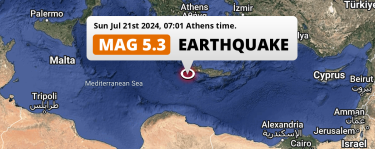Latest earthquakes near Greece today
Complete overview of the latest earthquakes near the country Greece, updated every minute. Did you feel an earthquake today in Greece? If an earthquake is happening right now near Greece (also known as Ελλάς), it will show up within minutes.
Recent Greece Earthquake News
These are the latest articles published related to earthquakes occurring near Greece. Check our Earthquake News section for a complete overview of articles written on earthquakes near Greece and elsewhere.
Greece Earthquake Statistics
Average
A total of 3145 earthquakes with a magnitude of four or above have struck within 300 km (186 mi) of Greece in the past 10 years. This comes down to a yearly average of 314 earthquakes per year, or 26 per month. On average an earthquake will hit near Greece roughly every 1 days.
A relatively large number of earthquakes occurred near Greece in 2020. A total of 523 earthquakes (mag 4+) were detected within 300 km of Greece that year. The strongest had a 7 magnitude.

Magnitude Distribution
The table below visualizes the distribution of all earthquakes that occurred within 300km of Greece in the past 10 years. No earthquakes with a magnitude of 7 or above have occurred near Greece during this time. Usually, higher magnitudes are less common than lower magnitudes. Small earthquakes with a magnitude below 4 on the Richter scale have been omitted from this overview.
| Magnitude | Earthquakes | Percentage |
|---|---|---|
| Mag. 4 | 2957 | 94.02% |
| Mag. 5 | 177 | 5.63% |
| Mag. 6 | 10 | 0.32% |
| Mag. 7 | 1 | 0.03% |
| Mag. 8 | 0 | 0.0% |
| Mag. 9 | 0 | 0.0% |
| Mag. 10 | 0 | 0.0% |
Strongest earthquakes near Greece
The strongest recent earthquake of the past 10 years near Greece occurred on Oct 30, 2020 13:51 local time (Europe/Athens timezone). It had a magnitude of 7 and struck 268 kilometers (167 mi) east of Athens, at a depth of 21 km. Discover more strong earthquakes near Greece in the list below.
A longer time ago, a MAG-7.7 earthquake struck on Jul 9, 1956 05:11, 166 kilometers (103 mi) east of Irákleion. It is the strongest earthquake near Greece in the past 124 years (Our data goes back to January 1st, 1900).
In the table below you will find the strongest earthquakes that occurred near Greece in the past 10 years. You can use the tabs to find the heaviest historic earthquakes since the year 1900 or within a specific year or distance from Greece.
Earthquakes by region of Greece
Click the links below for earthquake reports for regions in Greece.
- Attica (Αττική)
- Central Greece (Κεντρική Ελλάδα)
- Central Macedonia (Κεντρική Μακεδονία)
- Crete (Κρήτη)
- East Macedonia and Thrace (Eastern Macedonia and Thrace)
- Epirus (Ήπειρος)
- Ionian Islands (Ιόνια Νησιά)
- North Aegean
- Peloponnese (Πελοπόννησος)
- South Aegean (Νότιο Αιγαίο)
- Thessaly (Θεσσαλία)
- West Greece (Δυτική Ελλάδα)
- West Macedonia (Δυτική Μακεδονία)
Frequently Asked Questions
These questions are commonly asked in relation to earthquakes occurring near Greece.
When was the last earthquake in Greece?
A 2.5 magnitude earthquake hit near Greece on the morning of July 27, 2024 at 08:09 local time (Europe/Athens). The center of this earthquake was located 141km east of Mytilene at a depth of 7km under land. Check the list on our website for any earthquakes occurring near Greece in the past hours.
What was the strongest earthquake near Greece?
A 7.7 magnitude earthquake hit near Greece on the night of July 9, 1956 at 05:11 local time (Europe/Athens). The center of this earthquake was located 166km north-northeast of Irákleion at a depth of 20km under water in the Aegean Sea. This is the strongest earthquake that occurred near Greece since the year 1900.
How often do earthquakes occur near Greece?
In the past 10 years, 3145 earthquakes with a magnitude of four or higher occurred within a 300 kilometer range from Greece. This averages to 315 earthquakes yearly, or one earthquake every 1 days.

 Jul 21, 2024 07:01AM
On Sunday Morning a Significant M5.3 Earthquake struck in the Mediterranean Sea near Chaniá (Greece).
Jul 21, 2024 07:01AM
On Sunday Morning a Significant M5.3 Earthquake struck in the Mediterranean Sea near Chaniá (Greece).
